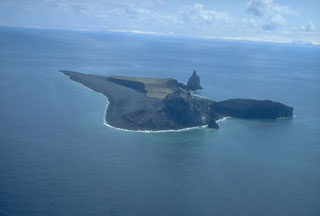Report on Bogoslof (United States) — 31 May-6 June 2017
Smithsonian Institution / US Geological Survey
Weekly Volcanic Activity Report, 31 May-6 June 2017
Managing Editor: Sally Sennert.
Please cite this report as:
Global Volcanism Program, 2017. Report on Bogoslof (United States) (Sennert, S, ed.). Weekly Volcanic Activity Report, 31 May-6 June 2017. Smithsonian Institution and US Geological Survey.
Bogoslof
United States
53.93°N, 168.03°W; summit elev. 150 m
All times are local (unless otherwise noted)
AVO reported that a short-duration (less than 10 minute) explosion at Bogoslof began at 1842 on 31 May based on seismic and infrasound data. A volcanic cloud identified in satellite images rose 7.3 km (24,000 ft) a.s.l., drifted WNW, and dissipated over the Bering Sea. The explosion was preceded by a several hour-long swarm of very small earthquakes. Seismicity decreased in the hours prior to the explosion and remained below the detection threshold. A sulfur dioxide plume from an explosion on 28 May was visible in satellite data drifting over the Hudson Bay region of Canada on 2 June. A short-duration explosive event at 0750 on 5 June produced a small volcanic cloud observed by a pilot. Low-amplitude tremor was detected in seismic data beginning at about 1229 on 5 June but then decreased to background levels. A vessel in the area reported vigorous steaming and a white plume rising several thousand feet above sea level. A brief explosive event was detected at 0600 on 6 June. The event likely produced a low-level (less than 3 km or 10,000 ft a.s.l.) emission; a possible plume at 1.8 km (6,000 ft) a.s.l. was identified in a satellite image following the detection of the activity in seismic and infrasound data, but quickly dissipated. The Aviation Color Code remained at Orange and the Volcano Alert Level remained at Watch.
Geological Summary. Bogoslof is the emergent summit of a submarine volcano that lies 40 km N of the main Aleutian arc. It rises 1,500 m above the Bering Sea floor. Repeated construction and destruction of lava domes at different locations during historical time has greatly modified the appearance of this "Jack-in-the-Box" volcano and has introduced a confusing nomenclature applied during frequent visits by exploring expeditions. The present triangular-shaped, 0.75 x 2 km island consists of remnants of lava domes emplaced from 1796 to 1992. Castle Rock (Old Bogoslof) is a steep-sided pinnacle that is a remnant of a spine from the 1796 eruption. The small Fire Island (New Bogoslof), about 600 m NW of Bogoslof Island, is a remnant of a lava dome formed in 1883.
Source: US Geological Survey Alaska Volcano Observatory (AVO)

